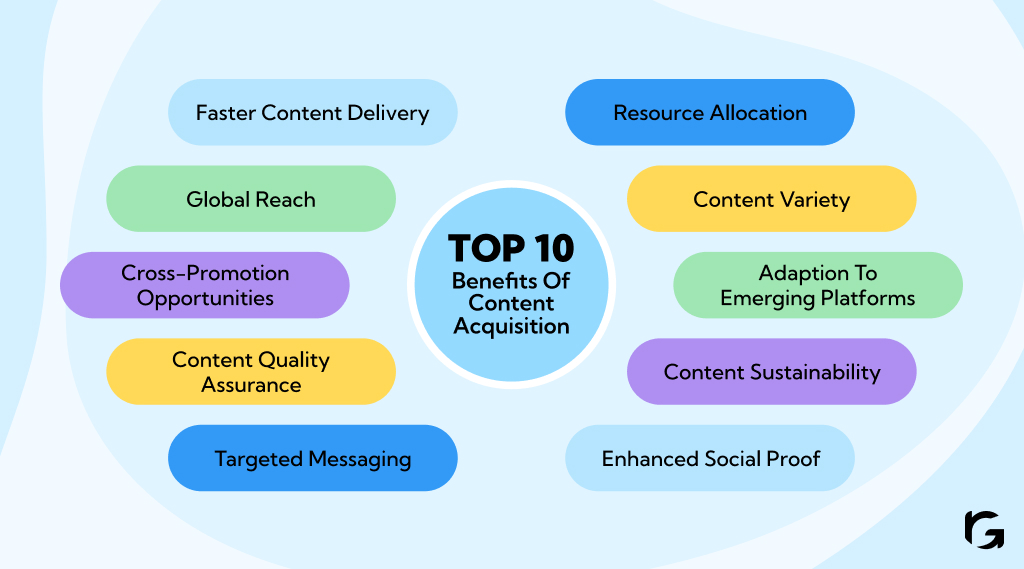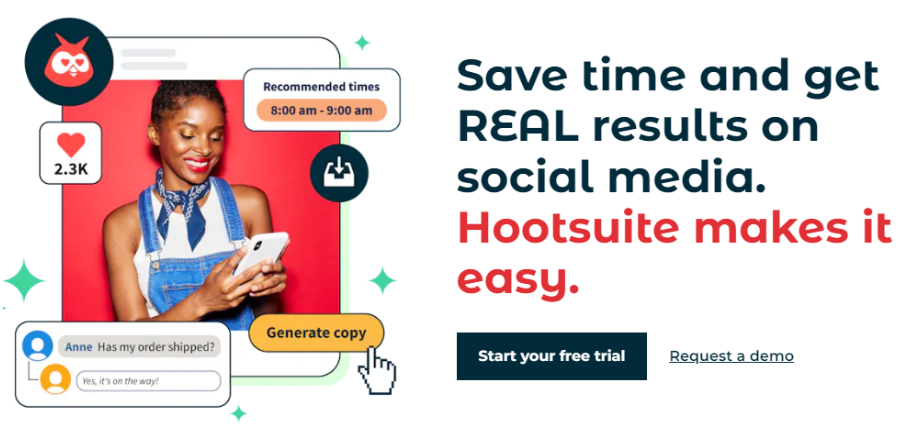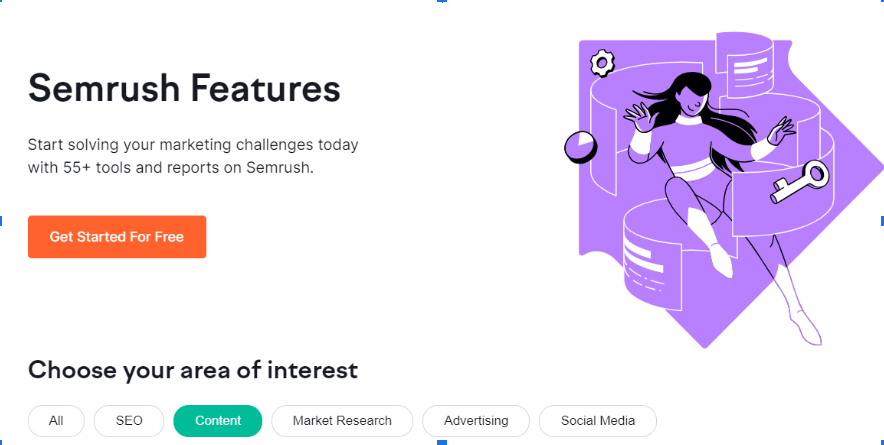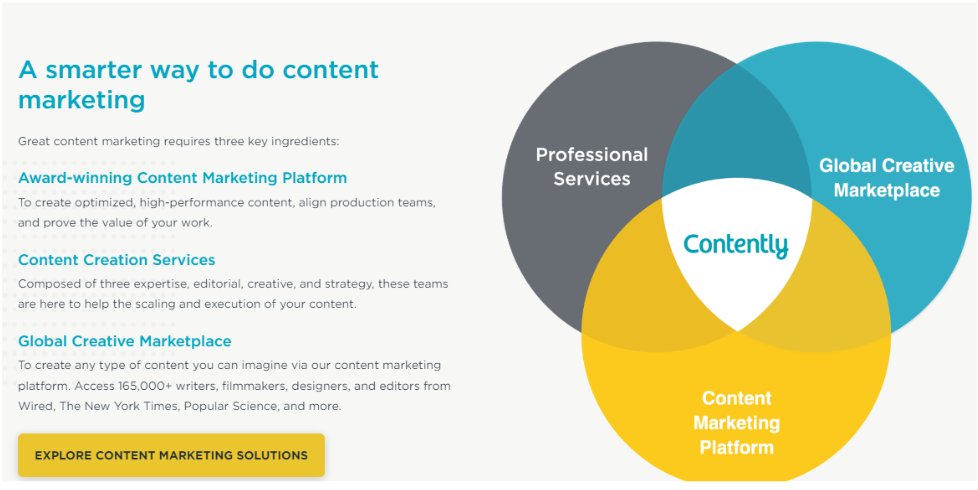We all know content is king. However, creating high-quality content consistently can be a challenging task. That’s where content acquisition comes in. It’s the process of finding valuable content to boost your platform’s engagement.
In this article, we will help you understand content acquisition, why it is important, its examples, the steps involved in it, and much more.
So, let’s dive right in!
What is content acquisition in 2024?
Content acquisition is the process of sourcing or creating content for use across various platforms, such as websites, streaming services, television, and radio.
This content can range from written articles, videos, and images to more complex forms like software and interactive media.
Content acquisition aims to enrich a platform or service with material that engages, informs, or entertains the audience, thereby adding value to the user experience.
The process involves several key steps:
- Identification
- Sourcing
- Licensing and rights management
- Content integration
1. Identification
Identify the type of content needed based on audience, market trends, and the platform’s goals. Look for the content sources that can align with your company’s values. This process is the foundation and most important step of the whole content acquisition strategy.
2. Sourcing
It is the process of finding content creators or distributors from whom the desired content can be obtained. This can involve negotiating with individual creators, partnering with content production companies, or purchasing rights from content libraries. It also includes researching content producers and businesses in the industry with the help of content marketing platforms. You can use various tools to search sources of content.
3. Licensing and rights management
It is the process of negotiating terms and conditions, such as duration of use, exclusivity, and geographical limitations. Licensing content can be more cost-effective than buying content, as it allows companies to reuse articles that have already been edited and fact-checked, rather than hiring freelance writers to create bespoke content.It is a flexible solution for companies looking for cost effective options.
4. Content integration
Content integration is the process of combining newly acquired content with existing content to create a new content portfolio. By integrating new content, companies can maintain brand identity, engage with their target audience and achieve their content marketing goals.
Content acquisition is important for businesses who run on content, such as streaming services, publishers, and educational platforms, as it directly impacts their ability to attract and retain users.
Effective content acquisition strategies can lead to a diverse and appealing content library, addressing a wide audience and building loyalty. Poor content acquisition can affect the platform’s competitiveness and growth.
Netflix content acquisition: A quick sneak peek
Netflix’s content acquisition strategy is a cornerstone of its success as a leading streaming platform, focusing on securing a wide range of high-quality, diverse content related to its global audience.
This involves negotiating and purchasing rights to movies, TV shows, documentaries, and more from studios, independent filmmakers, and content distributors around the world.
Additionally, Netflix invests heavily in original content, commissioning and producing its own series, films, and documentaries to ensure it offers unique, exclusive content that differentiates it from competitors.
The aim is to keep the library fresh, engaging, and varied to retain existing subscribers and attract new ones, adapting to changing viewer preferences and expanding into new markets with localized content.
Top 10 benefits of content acquisition

Content acquisition is important for several reasons because it fuels platforms with engaging and relevant material, driving user satisfaction, loyalty, and growth. And here are the top ten benefits of content acquisition.
- Faster content delivery
- Global reach
- Cross-promotion opportunities
- Content quality assurance
- Targeted messaging
- Resource allocation
- Content variety
- Adaption to emerging platforms
- Content sustainability
- Enhanced social proof
Let’s understand these benefits in detail.
1. Faster content delivery
Content acquisition expedites the content creation process. By sourcing pre-existing content or curated materials, companies can swiftly respond to emerging trends, events, or customer inquiries without lengthy content production cycles.
2. Global reach
Content acquisition provides access to diverse content from various sources. This global perspective allows companies to connect with a more geographically dispersed audience and gain a broader international appeal.
3. Cross-promotion opportunities
Collaborating with content providers or creators in your niche offers cross-promotion potential. By sharing each other’s content, companies can tap into each other’s audiences and expand their reach.
4. Content quality assurance
Acquiring content from reputable sources or creators can enhance quality and reliability. It helps in maintaining a high standard of content that resonates with the audience.
5. Targeted messaging
Through content acquisition, companies can precisely target different audience segments with tailored content. This approach ensures that the right content reaches the right audience, increasing its impact.
6. Resource allocation
Content acquisition allows companies to allocate their in-house resources more effectively. Internal teams can focus on core functions and creative endeavors by outsourcing certain content needs.
7. Content variety
Content acquisition introduces various content formats, from podcast to interactive quizzes, enriching the user experience and catering to different learning and engagement styles.
8. Adaptation to emerging platforms
Content acquisition enables companies to adapt quickly as new digital platforms and channels emerge. They can source content suitable for emerging platforms and engage with evolving audiences.
9. Content sustainability
Licensing or using user-generated content can contribute to content sustainability. This is particularly valuable for evergreen content that remains relevant over extended periods.
10. Enhanced social proof
Sharing user-generated content, including positive reviews and testimonials, enhances social proof. It bolsters the brand’s reputation by showcasing satisfied customers’ real-life experiences and opinions.
It helps in building brand’ reputation by showcasing real life experiences of customers.
Adding content acquisition into content marketing help companies to reach global markets and gain extra benefits
7 Content acquisition examples you should know
Content acquisition is a fundamental aspect of any successful digital marketing strategy. Businesses and content creators must diversify their approach to sourcing and creating engaging content that resonates with their target audience.
Here are seven examples of content acquisition, each illustrating a different facet of this essential activity:
- User-generated content (UGC)
- Content syndication
- Content curation
- Guest blogging
- Influencer marketing
- Content licensing
- Repurposing content
1. User-generated content (UGC)
UGC is a powerful way to use your audience’s voice. It involves encouraging your customers or followers to create content related to your brand, products, or services. This content can include product reviews, testimonials, social media posts, or even user-submitted photos and videos. UGC not only builds trust and authenticity but also lightens the content creation load for your team.
2. Content syndication
Content syndication is a process of sharing your existing content with other websites or publishers. This can be done through partnerships, content networks, or platforms specializing in syndication. You can reach a large audience with the help of content syndication.
3. Content curation
Content curation is the process of organizing, and sharing relevant content from various sources, in your industry or niche. It allows you to provide valuable information to your audience without creating content from scratch. Curating content helps you establish yourself as an expert in your field and can be a valuable resource for your audience.
4. Guest blogging
Guest blogging is a mutually beneficial arrangement where you write articles or blog posts for other websites in your niche. In return, you receive a byline and a link back to your own site. This expands your reach and enhances your website’s search engine optimization (SEO) by earning backlinks from reputable sources.
5. Influencer marketing
Influencer marketing involves partnering with individuals with a substantial following and influence in your industry. These influencers create or promote content related to your brand. Collaborating with influencers can introduce your products or services to a wider, more engaged audience and benefit from the influencer’s credibility and trustworthiness.
6. Content licensing
Content licensing is a strategy where you sell or grant permission for others to use your content. This can include images, videos, articles, or other media assets. By licensing your content to other organizations, you can generate additional revenue and increase your content’s exposure, as long as it’s properly attributed to you.
7. Repurposing content
Repurposing content is the process of using existing content to transform it into different formats or for different platforms. For example, you might turn a blog post into a video, an infographic, a podcast, or an ebook. This allows you to maximize the value of your existing content, cater to different audience preferences, and reinforce key messages across various channels.
These content acquisition strategies can help you diversify your content portfolio, reach new audiences, and enhance your brand’s online presence while efficiently using your resources.
How to create a content acquisition strategy? 12 Steps
Creating a content acquisition strategy is crucial for maintaining a dynamic online presence and engaging your target audience effectively. Such a strategy involves several key steps and considerations. Here’s a guide to framing a content acquisition strategy:
- Identify your objectives
- Know your target audience
- Content types and formats
- Content calendar
- Content sources
- Keyword and SEO strategy
- Distribution channels
- Promotion and outreach
- Measure and analyze
- Budget and resources
- Adapt and evolve
- Legal and ethical considerations
1. Identify your objectives
Define your goals clearly like: What do you want to achieve with your content acquisition strategy? Is it to increase brand awareness, drive website traffic, or boost sales? Understanding your objectives will guide the rest of your strategy.
2. Know your target audience
Understanding your target audience is very important. . Know what are their interests, pain points, and preferences? It will help you create content that is related to your audience.
3. Content types and formats
Choose content which is suitable for your audience. . This may include blog posts, videos, infographics, podcasts, etc. Additionally, consider the formats – long-form, short-form, visual, or interactive.
4. Content calendar
Create a content calendar that will define when and what content you will be producing. . This ensures a consistent flow of content and keeps your audience engaged.
5. Content sources
Determine where your content will come from. Will you primarily create it in-house, rely on user-generated content, collaborate with influencers, or curate content from other sources?
6. Keyword and SEO strategy
Incorporate search engine optimization (SEO) into your content acquisition plan. Identify relevant keywords and phrases to enhance your content’s visibility on search engines.
7. Distribution channels
Decide where and how you’ll distribute your content. This could include your website, social media platforms, email marketing, and partnerships with other websites.
8. Promotion and outreach
Develop a strategy for promoting your content. This might involve outreach to industry influencers, running paid advertising campaigns, or leveraging email marketing to reach a broader audience.
9. Measure and analyze
Implement tools and metrics to track the performance of your content. key performance indicators (KPIs) include website traffic, social shares, and conversion rates. Regularly analyze these metrics to adjust your strategy accordingly.
10. Budget and resources
Allocate your budget and resources effectively. Consider factors such as content creation costs, paid promotions, and the tools required for analytics and SEO.
11. Adapt and evolve
Be prepared to adapt and evolve your content acquisition strategy as new technologies and trends emerge.
12. Legal and ethical considerations
Ensure that your content acquisition methods comply with legal and ethical standards, particularly when dealing with user-generated content, licensing, and influencer partnerships.
A well-structured content acquisition strategy helps you stay relevant and competitive and ensures that your content resonates with your target audience, leading to increased engagement and brand success.
Top 9 content acquisition tools to try in 2024
Here are nine content acquisition tools that can be valuable for enhancing your content strategy:
- Buzzsumo
- Hootsuite
- SEMrush
- Contently
- Canva
- Google Trends
- Mailchimp
1. BuzzSumo

BuzzSumo helps you discover your niche’s most popular and trending content. It also provides insights on top-performing content and the influencers who share it.
2. Hootsuite
 Hootsuite is a social media management platform that simplifies content distribution. You can schedule posts, engage with your audience, and monitor your social media presence.
Hootsuite is a social media management platform that simplifies content distribution. You can schedule posts, engage with your audience, and monitor your social media presence.
3. SEMrush

SEMrush is an all-in-one SEO tool that assists in keyword research, tracking your website’s performance, and analyzing your competitors’ strategies.
4. Contently

Contently is a content marketing platform that connects you with skilled freelance writers and creators to help produce high-quality content.
5. Canva

Canva is a user-friendly graphic design tool that simplifies the process of creating visually appealing content, including images, infographics, and social media graphics.
6. Google Trends

Google Trends provides valuable insights into trending topics and keyword popularity. This helps you create content that is relevant and current.
7. Mailchimp

Mailchimp is a popular email marketing platform that helps you manage email campaigns, segment your audience, and deliver your content directly to subscribers’ inboxes.
These tools cover a range of content acquisition needs, from content discovery and creation to distribution, SEO, and project management. Depending on your specific requirements and goals, you can incorporate these tools into your content strategy to improve efficiency and effectiveness.
Conclusion
Content acquisition is a critical aspect of any successful business or organization. It involves acquiring, creating, and managing content that is valuable to the target audience. Effective content acquisition requires a deep understanding of the audience’s needs, preferences, and behaviors, as well as the ability to create high-quality content that resonates with them.
If you want to build an effective content acquisition strategy, Revv Growth can help you in increasing engagement, and ultimately drive growth for your business.
Start revolutionizing your content strategy today. Get in touch with our team to learn more about content acquisition!
FAQs
1. What is the basic concept of acquisition?
The basic concept of acquisition refers to the process of one company buying another company or its assets, typically to expand its operations, market share, or capabilities. This can be achieved through mergers, takeovers, or asset purchases. The aim is often to achieve synergy, diversify, or gain a competitive edge in the market.
2. What is an example of content acquisition?
An example of content acquisition is when a company encourages customers to submit product reviews or user-generated content on their website. By doing so, they acquire valuable content generated by their audience, which can enhance trust and engagement with the brand.
3. What are digital acquisition tools?
Digital acquisition tools are software or platforms used in digital marketing to acquire, track, and engage with potential customers. These tools can include customer relationship management (CRM) software, email marketing platforms, SEO and SEM tools, social media management systems, and analytics platforms.
4. How do I get into content acquisition?
To get into content acquisition, you need to focus on creating valuable and relevant content to attract and retain a specific audience. This involves developing a strategic marketing approach that emphasizes the distribution of consistent and high-quality content across various channels like websites, blogs, social media, and email.
5. What does a content acquisition manager do?
A content acquisition manager negotiates and secures licenses or partnerships for acquiring digital or physical content to meet the organization’s needs and goals.
6. How do you acquire content?
Content acquisition involves researching potential sources, negotiating licensing agreements or partnerships, and procuring digital or physical content through legal means to meet specific needs or objectives. This process may include purchasing, licensing, or collaborating with content creators, distributors, or rights holders.
7. How much does content acquisition cost?
The cost of content acquisition can vary widely depending on the industry and the specific methods used for acquisition. For B2C self-serve SaaS companies, the Customer Acquisition Cost (CAC) can range anywhere between $100 – $500.
This cost is influenced by factors such as the monthly recurring revenue of a single customer (MRR), the lifetime value of a single customer (LTV), and the marketing channels used for acquisition.



